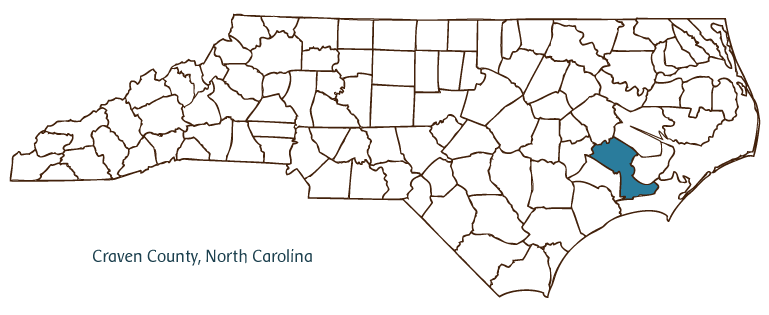Craven County Resources
- View All:
- Biographies
- Monuments
- locations
Copyright Notice: This article is from the Encyclopedia of North Carolina edited by William S. Powell. Copyright © 2006 by the University of North Carolina Press. Used by permission of the publisher. For personal use and not for further distribution. Please submit permission requests for other use directly to the publisher.

Craven County, located in the Coastal Plain region of eastern North Carolina, lies within one of early North Carolina's most important regions. Formed in 1705, it was originally called Archdale Precinct of Bath County; in 1712 the name was changed to Craven County in honor of the earl of Craven, one of the Lords Proprietors. New Bern, the county seat, was settled in 1710 and incorporated in 1723. The town was founded by Baron Christoph von Graffenried and named for the city of Bern, Switzerland. New Bern served as the primary seat of colonial government in the 1740s and later as the state capital of North Carolina until the establishment of Raleigh in 1792. Other Craven County communities include Bridgeton, Cove City, Trent Woods, Vanceboro, Havelock, and Dover. Notable physical features include the Neuse River, Catfish Lake, Palmetto Swamp, Hog Island, and Johnson Point.
Eighteenth-century Craven County was home to North Carolina's first newspaper, the North-Carolina Gazette (New Bern, 1751), as well as its first chartered school, New Bern Academy (1764). New Bern continues to be the economic center of the county, with a thriving commercial environment and an important historic district, centered around the restored 1770 colonial capital. The Tryon Palace Historic Sites and Gardens is one of the state's most popular historic attractions. Among the county's other important landmarks and historic sites are the Harvey Mansion (1798), the James Riggs House (ca. 1830), and St. John's Masonic Lodge and Theater (1801). The former pharmacy where Caleb Bradham invented Pepsi-Cola in the 1890s is a point of interest in New Bern. Cultural institutions in Craven County include the Fireman's Museum, New Bern Civic Theater, Atlantic Dance Theater, Union Point Park, and Craven Concerts. The county hosts annual events such as the Chrysanthemum Festival, North Carolina Festival, Bridgeton Blueberry Festival, and Festival of Colonial Life.
Craven County's agricultural products include horticultural crops, soybeans, tobacco, corn, cotton, peanuts, swine, beef cattle, and chickens. Manufactured products include textiles, computer components, plumbing products, furniture, and power tools. Minerals such as lime and shell stone are also mined in the county. In 2004 Craven County's population was estimated to be 92,000.
For an annotated history of the county's formation, with the laws affecting the county, boundary lines and changes, and other origin information, visit these references in The Formation of the North Carolina Counties (Corbitt, 2000), available online at North Carolina Digital Collections (note, there may be additional items of interest for the county not listed here):
County formation history: https://digital.ncdcr.gov/Documents/Detail/the-formation-of-the-north-ca...
Index entry for the county: https://digital.ncdcr.gov/Documents/Detail/the-formation-of-the-north-ca...
References:
Peter B. Sandbeck, The Historic Architecture of New Bern and Craven County, North Carolina (1988).
Additional resources:
Corbitt, David Leroy. 2000. The formation of the North Carolina counties, 1663-1943. https://digital.ncdcr.gov/Documents/Detail/the-formation-of-the-north-carolina-counties-1663-1943/3692099?item=4553233 (accessed June 20, 2017).
Craven County Government: http://www.cravencounty.com/
Havelock Chamber of Commerce: https://www.havelockchamber.org/
New Bern Chamber of Commerce: https://www.newbernchamber.com/
DigitalNC, Craven County: https://www.digitalnc.org/counties/craven-county/
North Carolina Digital Collections (explore by place, time period, format): https://digital.ncdcr.gov
Image credits:
Rudersdorf, Amy. 2010. "NC County Maps." Government & Heritage Library, State Library of North Carolina.
Powell, William S. "Craven County." NCpedia. State Library of NC. 2006. https://www.ncpedia.org/geography/craven.
CRAVEN COUNTY GOVERNMENT:
https://www.cravencountync.gov/
COUNTY SEAT: New Bern
FORMED: 1705
FORMED FROM: Bath
LAND AREA: 708.96 square miles
2020 POPULATION ESTIMATE: 100,720
White: 71.8%
Black/African American: 21.4%
American Indian: 0.7%
Asian: 2.9%
Pacific Islander: 0.2%
Two or more races: 3.0%
Hispanic/Latino: 7.6% (of any race)
From State & County QuickFacts, US Census Bureau, 2020.
CONGRESSIONAL DISTRICT: 3RD
BIOGRAPHIES FOR![]()
Craven County
 WILDLIFE PROFILES FOR
WILDLIFE PROFILES FOR
Coastal Plain
GEOGRAPHIC INFORMATION
REGION: Coastal Plain
RIVER BASIN: Neuse, Map
NEIGHBORING COUNTIES: Beaufort, Carteret, Jones, Lenoir, Pamlico, Pitt